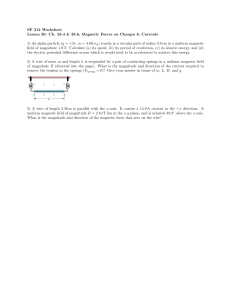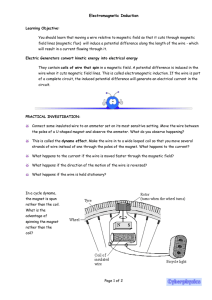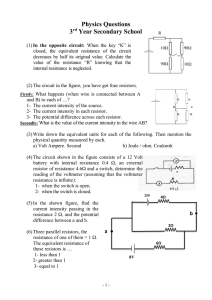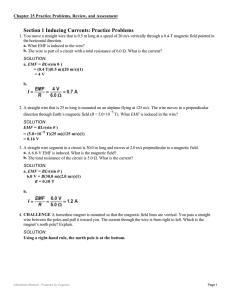Physics 114 Exam 3 Spring 2013
advertisement
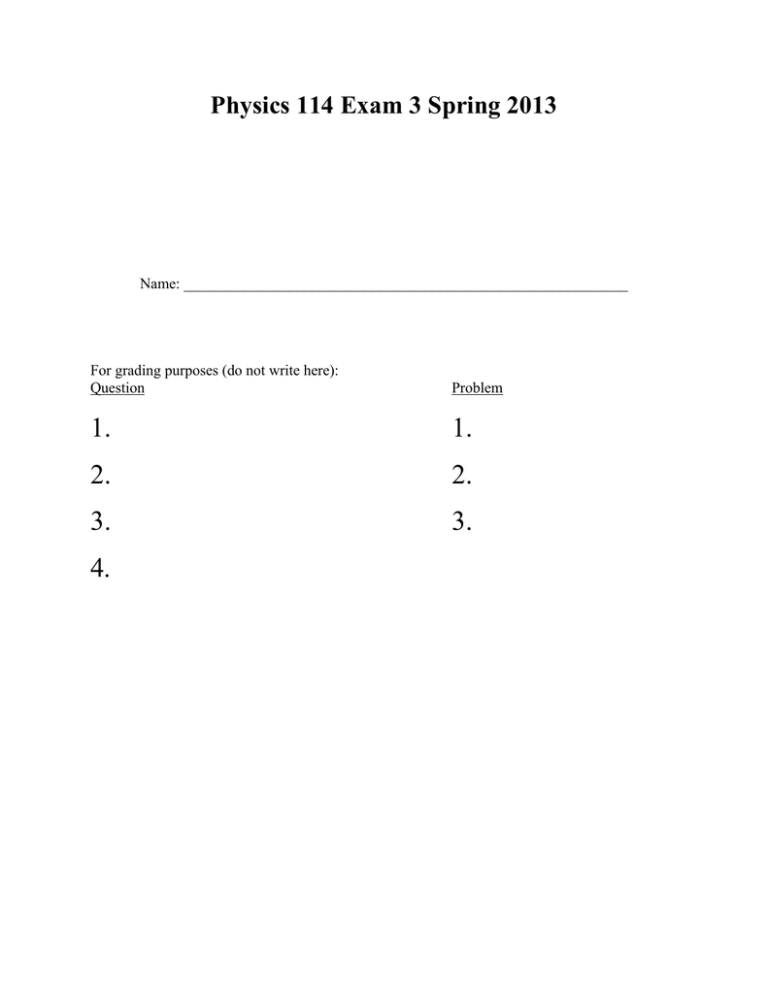
Physics 114 Exam 3 Spring 2013 Name: ___________________________________________________________ For grading purposes (do not write here): Question Problem 1. 1. 2. 2. 3. 3. 4. Question 1 (10 points). Determine the initial direction of the deflection of charged particles as they enter the magnetic fields shown in the figure below. Solutions: a) Up b) Out of page c) No deflection d) Into page Question 2 (10 points). For each of the following currents drawn below (in blue), state which way the magnetic field points at the point P indicated (in red). Assume current wires are infinitely long. Draw the field and describe it too (up, down, left, right, into page, out of page). A. P I B. I P C. Current out of page. I out of page P Solutions: a) Out of page b) Out of page c) Up Question 3 (10 points). (a) Rank the magnitudes of from greatest to least. (b) Rank the magnitudes of Solutions: a) C>A>D>B b) C=A=B>D ·d for the closed paths in the figure, ·d for the closed paths in the figure, from greatest to least. Question 4 (10 points). Two circuits are shown below in which a conducting bar is slid at the same speed, v, through the same uniform magnetic field along a U-shaped wire. The parallel lengths of the wire are separated by 2L in circuit 1 and by L in circuit 2. The current induced in circuit 1 is clockwise. (a) What is the direction of the magnetic field? (b) Is the current in circuit 1 larger, smaller, or the same as that in circuit 2? Solutions: a) Clockwise current gives a counter-field into the page. Thus the original field is out of the page. b) The change in flux per unit time is greater in (1) due to the larger area, so the induced current is larger. Now consider the two coils wrapped around non-conducting rods below. Coil X is connected to a battery and a variable resistance. What is the direction of the induced current through current meter (Ammeter) in coil Y (say left to right, right to left, or no current) (c) when coil Y is moved toward coil X (d) when the current in coil X is decreased without any change in relative positions of the coils? Solutions: c) Flux through Y increases to the right. The counter field needs to be to the left. So current goes right to left through the meter. d) Now flux decreases to the right. Want counter field to be to right. Current goes left to right through the meter. Problem 1 (15 points). A particle with a mass of 0.2 Kg and charge of 5 C travelling in the y-direction with a speed of 20 m/s enters a magnetic field and is acted upon by a magnetic field and experiences an acceleration of 10 m/s2 in the x-direction. (a) What is the magnitude of the net force on the particle? (b) Determine the components of the magnetic field (Bx, By,Bz) and if a component is undetermined state that it is. (c) Now say that the field determined in part B is turned off and, while the particle is again travelling in the y-direction with a speed of 20 m/s, a new field is turned on given by ˆ , determine the force on the particle by this new field (remember B = (2iˆ + 0.5jˆ + 0.1k)T force is a vector). Solutions: a) F = ma = (0.2)(10) = 2 N b) We have F = 2 î , v = 20 ĵ . So F = q v X B gives 2 î = 5(20 ĵ ) X (Bx î + By ĵ + Bz k̂ ) = 100(-Bx k̂ +0 By + Bz î ) This shows that Bx = 0, By can be anything (undetermined), and Bz = 0.02 T ˆ = 100(-2 k̂ +0 + 0.1 î ) = (10 î - 200 k̂ ) T c) We have F = (5) 20 ĵ X (2iˆ + 0.5jˆ + 0.1k)T Problem 2 (15 points). Consider a wire that is bent into a right angle at point P that carries a current I = 3A. (a) What is the magnitude of the magnetic field at the point P? (b). What is the magnitude and direction of the field at q, assuming q is 10 m from P and 1 mm from the vertical wire (so these are very long wires)? Solutions: (a) The law of Biot Sarvart tells us that the field will be zero at p. The law involves a term ds X r, and these are perpendicular to each other so their cross product is zero. (b) The point is so close to the wire that we can assume we have an infinite wire. Then the magnitude of the field can be obtained from Ampere’s law so we have B = 0I/2r = (4 x 10-7)(3)/( 21X10-3) = 6X10-4 T Point q is to the right of the wire and so B is into the page. Problem 3 (15 points). The magnetic flux through the loop shown increases according to B = 6.0 t2 + 7.0 t, where B is in milliwebers and t is in seconds. (a) What is the magnitude of the emf induced in the loop at t = 2.0 s. (b) What is the direction of the current through R? (c) What is ∮ ∙ around the loop at the t = 2.0 s? Solutions: dΦ B = 12.0 t + 7 = (12)(2)+7 = 31 mV dt (b) B is increasing so flux is increasing out of page so induced field is into page so current in loop is clockwise so it goes from right to left in resistor. , so it is just the 31 mV found in part a. (c) ∮ ∙ (a) Faraday’s law says that 1 | q 1 || q 2 | 4 0 r 2 e = 1.6 X 10-19 C F Possibly Useful Information . 0 8.85 X 10 -12 (C 2 / N m 2 ) E Fq 0 | q| E 4 0 r 2 x = x2 - x1, t = t2 - t1 0 0 E. dA q enc s = (total distance) / t v = dx/dt a = v / t a = dv/dt = d2x/dt2 v = vo + at g = 9.8 m/s2 r = xi + yj + zk r = r2 - r1 x-xo = vot + (½)at2 v2 = vo2 + 2a(x-xo) v = x / t x-xo = vt -1/2at2 a = dv / dt r = (x 2 - x 1 ) i + (y 2 - y 1 ) j + (z 2 - z 1 ) k v = r / t , v = dr / dt a = v / t U = Uf - Ui = -W V = Vf - Vi = -W/q0 = U/q0 f Vf Vi E. ds U=-W∞ V = -W∞/q0 f V E. ds x-xo = ½( vo+ v)t i 1 q V 4 0 r V s V E s Q = CV Es l ln(b / a) C 4 0 R C 2 0 i n 1 n qi V Vi 4 0 i1 ri i 1 1 dq V 4 0 r V V V Ex ; Ey ; Ez x y z 1 q1q 2 U W 4 0 r12 A C 0 d ab C 4 0 ba C eq C j (parallel) 1 1 (series) C eq Cj Q2 1 2 CV 2 2C C = C0 U u 12 0 E 2 I= dQ/dt 1 L R A P = IV V = IR P = I2R=V2/R I (R r) Pemf = I 1 1 (parallel) R eq Rj I = (R)e-t/RC -t/RC I= (QRC)e , I0 = (QRC) F qv x B r = mv/qB, = qB/m dF Ids x B R eq R j (series) q(t)= Q(1-e-t/RC) q(t) = Qet/RC F IL x B = x B NIA U B Ids x r , 0= 4 x 10-7 T.m/A dB 0 4 r3 B = 0I/2r F/l = (0I1I2)/2a B = 0nI (solenoid) B .ds 0 I enc d B E. ds = N = Blv dt B B. dA B B .dA 0


